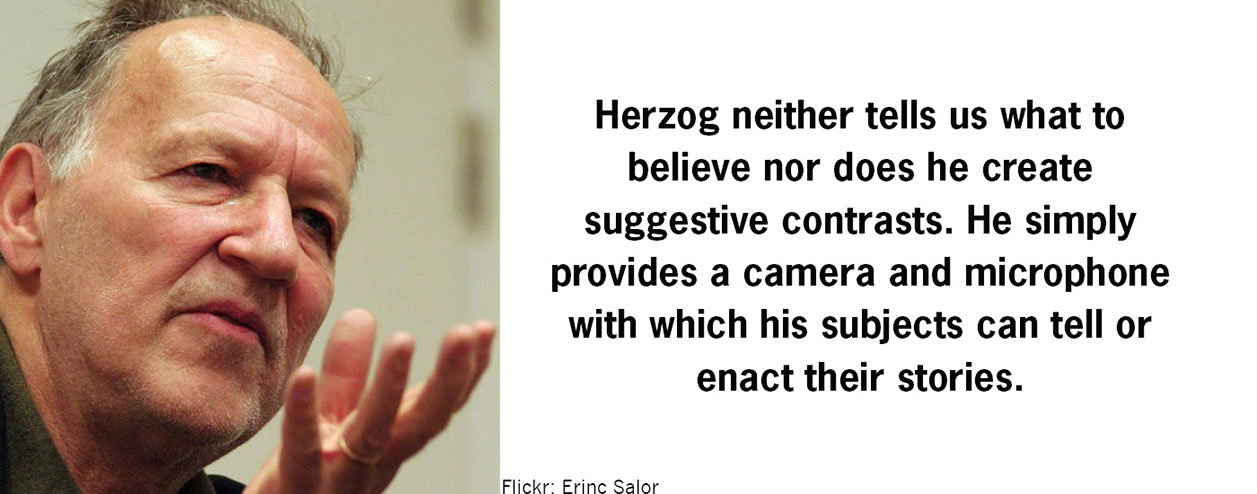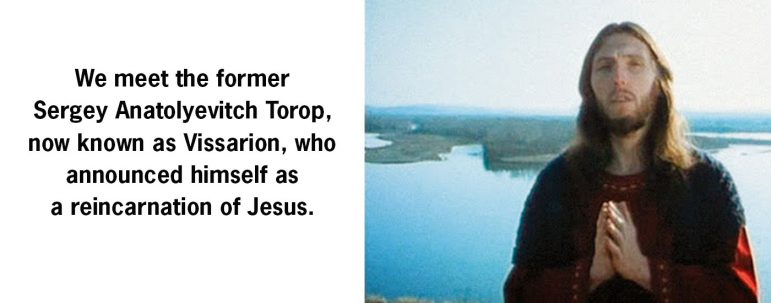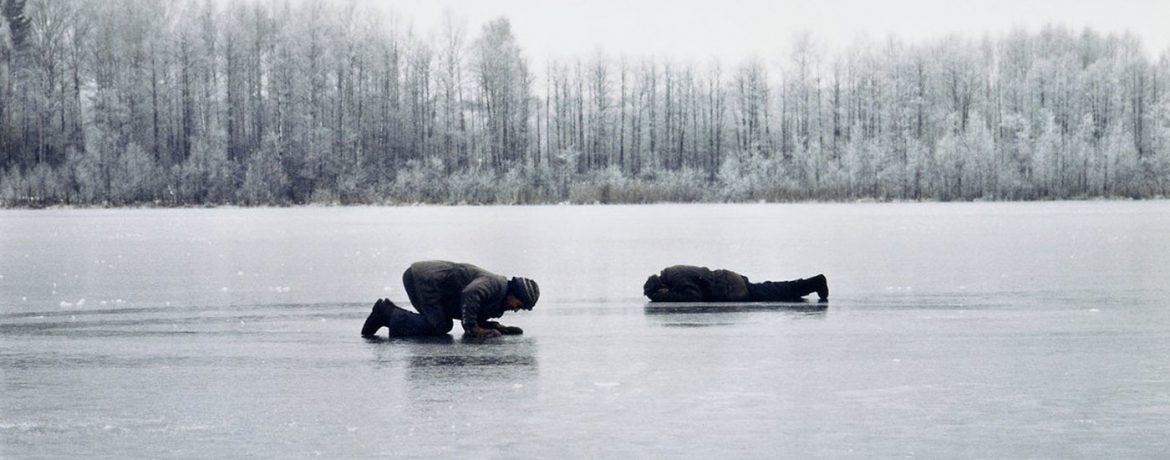Bells From the Deep is a foray into post-modern cinema. Here the director understands that any truth to be discovered will emerge as the film catalyzes thoughts, memories, and feelings already present in the mind of the viewer.
Bells takes us on a journey—at times profoundly aesthetic—into a seldom seen religious and mystical world where we observe a wide range of men and women, each engaged in his or her own quest for what Herzog might consider to be “ecstatic truth.”
In his essay, “Celluloid and Symbol,” Christian Century editor James Wall argues that, “The religious capacity of film is located not in its narrative but in the ‘evocative power’ of the overall artistic vision of its director.”
The wide-ranging films of Werner Herzog engage us with this “evocative power” derived from his illumination of the existential enigmas of human experience. They enable us to discover insights which contribute to our personal spiritual growth-in addition to moments of sheer beauty, awe, and irony which characterize his films.
Bells From the Deep is constructed using a sequence of vignettes depicting elements of mystical religious belief and practice in rural Russia. German film critic Eric Ames comments that, “Rather than explore ways of suggesting the appearance of the divine on screen, Herzog foregrounds the embodied aspect of religious devotion as displayed by people in ordinary acts of everyday faith.”
Herzog neither tells us what to believe nor does he create suggestive contrasts. He simply provides a camera and microphone with which his subjects can tell or enact their stories-stories resonating with mundane as well as ecstatic truth encountered in their rituals, pilgrimages, and personal reflections on life. Herzog translates the Russian and Tuvinian language commentary of his subjects into English with a calm, dispassionate voice which reveals his empathy for the feelings of his subjects. His strong German accent adds a trans-cultural feeling to the film.

Structure of the Film
The film begins its sequence of vignettes by silently implying a quest for metaphysical truth. Pilgrims lying on the frozen surface of a sacred lake attempt to hear the bells and see the lights of the mystical lost city of Kitezh believed to be at the bottom. We hear no narration, only the distant tolling of bells.
But this silent prelude in shades of blue winter light is soon broken by the shocking (to Western ears) sound of Tuva throat singing. Esoteric by its very nature, this vocal art exploits several methods enabling the practitioner to sing with up to four simultaneous voices. The singer strikes a fundamental tone and then, by varying the shape of the mouth, throat, and pharynx, is able to extract overtones and create melodies with them.
The camera then jumps to a family of Siberian nomads who have invited a shaman into their home to cleanse it of evil spirits blamed for making their children ill, to bless the home, and cleanse the family of their sins with incense. The family is preparing to move on with their herds and seeks advice from the shaman as to the best direction in which to proceed.
We next meet the former Sergey Anatolyevitch Torop, now known as Vissarion who, in 1990, after losing his job as a patrol officer in the town of Minusinsk in central Siberia, announced himself as a reincarnation of Jesus. At the present time his cult claims up to 50,000 adherents in 83 communities spread over 150 square kilometers. He gives us a short sermon focusing on ecological values laced with ideas drawn from Russian Orthodoxy, Buddhism, apocalypticism, and collectivism. He reiterates the core message of the gospel—love God and love your neighbor—while claiming to be one with the Father.
Vissarion immediately is followed by a village priest overseeing an infant baptism in a scene that is hard to distinguish from child abuse.
As elsewhere in these vignettes, the truth of the situation may best be glimpsed by looking at what is going on in the background in the faces and body language of observers. This is particularly true during the next scene of a public gathering in which villagers contemplatively drink water which has just been consecrated by a priest.
We encounter Alan Chumack, a well known Russian faith healer. We see him addressing a public audience. Attendees have brought bottles and containers of water and placed them on the edge of the stage in the belief that the water will absorb his healing power. When he appeared on television, his fans would place bottles of water next to their television sets for the same purpose. With a series of hand movements he transmits cosmic energy to his audience for healing.
We then meet Yuri Tarassov, a traveling sorcerer and exorcist. The camera follows him as he attempts to relieve the suffering of several hysterical individuals who have come to him seeking relief from their emotional and psychological distress.

We come upon Yuri Yurievich Yuriev, a simple bell ringer in a village cathedral. In my view Yuri’s truth comes closer to being poetically ecstatic than that of any other of Herzog’s characters. Yuri was orphaned during the years of the Stalin purges and reflects on the enigmatic nature of his life. He finds his joy in composing music for the bells using a series of old ropes and levers he has set up to control them. His final testimony is, “I am glad I can make people happy with my art. People need the sound of the bells.” Yui Yurievich Yuriev has shared with us some of the bells from his own deep in a triumph of creativity over circumstance.
The scene finishes with what Herzog critics have referred to as “the merciless gaze” in which the camera remains on the subject for a significant period of time after the subject has finished speaking. But these are moments which seem to reveal unspoken aspects of his characters.
An Orthodox priest appears on the screen and tells us the story of the sunken city of Kitezh. According to Russian legend hidden beneath the waters of Lake Svetloyar is the mythical city of Kitezh. Local people treat the lake as a place of sacred pilgrimage. The waters are considered by many to have healing and health giving properties. In calm weather-sometimes for the faithful-the sound of the singing of hymns and the ringing of bells of the Kitezh cathedral is heard coming from the lake. It is also said that those who are pure of heart and soul can see the buildings and the lights of the processions that the people of Kitezh still hold under the waters of the lake.
The camera then shifts to penitents and worshipers at the Zagorsk monastery in Sergiev Posad, the spiritual center of Russian Orthodoxy since the fourteenth century. There’s no narration in this scene which continues for more than four minutes; only the beautiful haunting choral melodies of the Choir of the Zagorsk Monastery. Candles are lit, blessings are given, worshipers cross themselves and lie prostrate on the floor in prayer.
The film approaches its conclusion with a revisiting of the opening scene of pilgrims on the ice of Lake Svetloyar attempting to see the lights of processions in the sunken city. The scene is controversial among connoisseurs of vérité in documentary because Herzog says he had to construct it. When he showed up at the lake in winter to film, there were no people around it; so he found some people in the local village to pose for him. No fan of vérité, Herzog insists on the value of truth over fact and the legitimacy of utilizing artifice in its construction in storytelling. In his words the “ecstatic truth” he seeks to reveal is “mysterious and elusive, and can be reached only through fabrication and imagination and stylization.”
A woman comes on the scene with a bandaged hand and proceeds to explain that she was attacked in her home by her pig. But her story gradually shifts to recounting an experience of seeing angels and hearing celestial singing near the lake.
Bells then concludes with a blessing from Vissarion.
Conclusions
Any truth to be found in Bells comes from our attempts to derive an overall meaning from the film by integrating our reactions to the various vignettes. The truth in Bells is poetic truth. It is found not in a narrative but rather in our own subjective reflections; the truth we find in Herzog’s films is not the same kind of truth we get from the evening news.
The poet Mark Strand once commented that, “You don’t read poetry for the kind of truth that passes for truth in the workaday world. You don’t read a poem to find out how you get to Twenty-Fourth Street.”
As in poetry, what separates a good film from a bad one is the film’s ability to embody layers of meaning. Werner Herzog may not tell us how to get to Twenty-Fourth Street, but his films do enable us sometimes to hear the tolling of the bells from the deep and faintly to glimpse the lights of the processions of the faithful.
Bells From the Deep is highly recommended for anyone interested in spirituality or the nuances of Russian folk religion.
Bells from the Deep: Faith and Superstition in Russia
Written and directed by Werner Herzog
Genre: Documentary
Runtime: 60 minutes
Release date: 7 September 1993
Music: Native Tuva singers, Choir of the Spiritual Academy in St. Petersburg, Choir of the Zagorsk monasery.
Shot in Super 16mm film with monaural sound by Jörg Schmidt-Reitwein
Available on YouTube
David Kantor is the producer/director of Reimagining Jesus. His next film explores how the life and teachings of Jesus have been manifest in religious practice over the past 2000 years.
